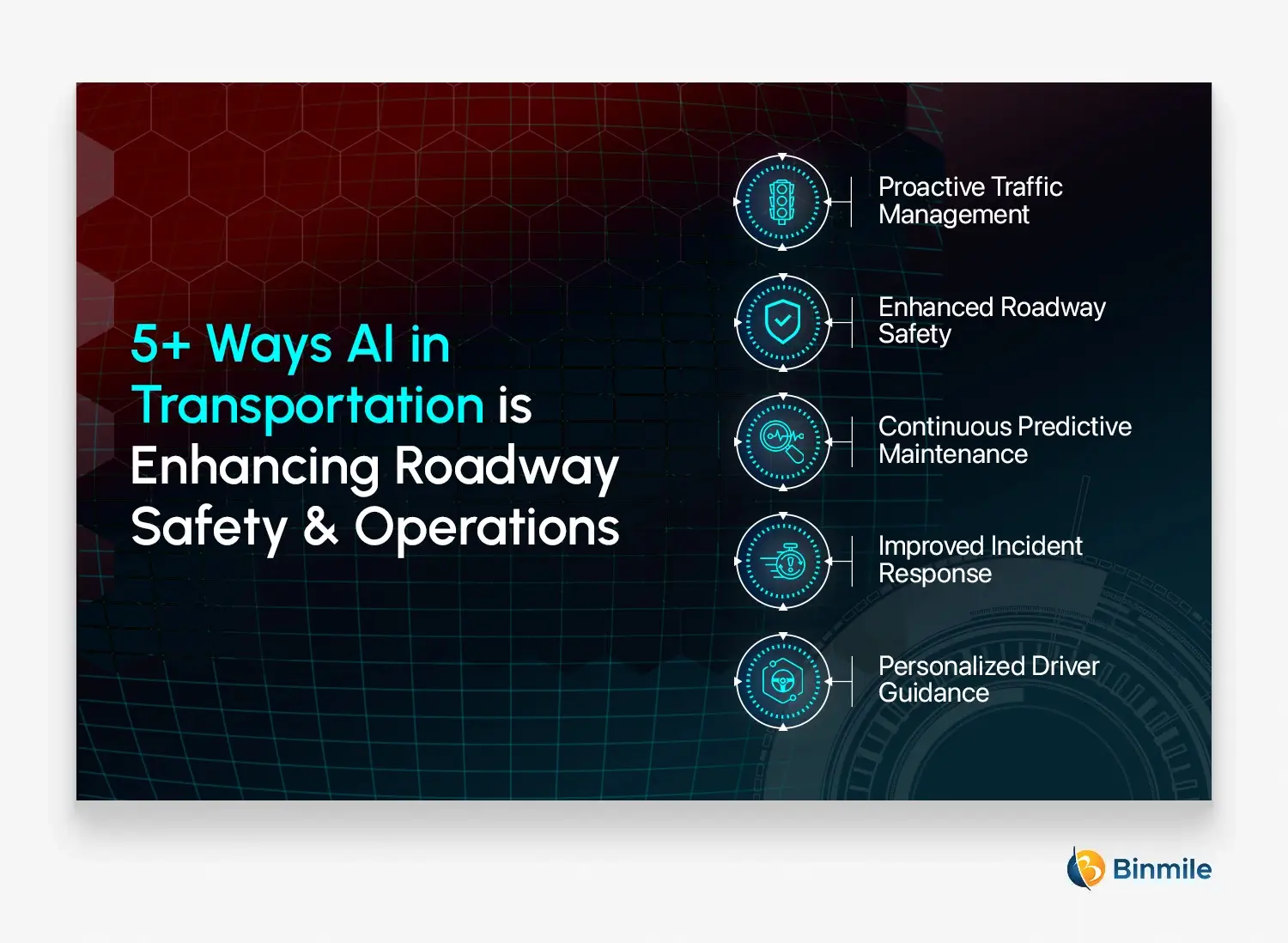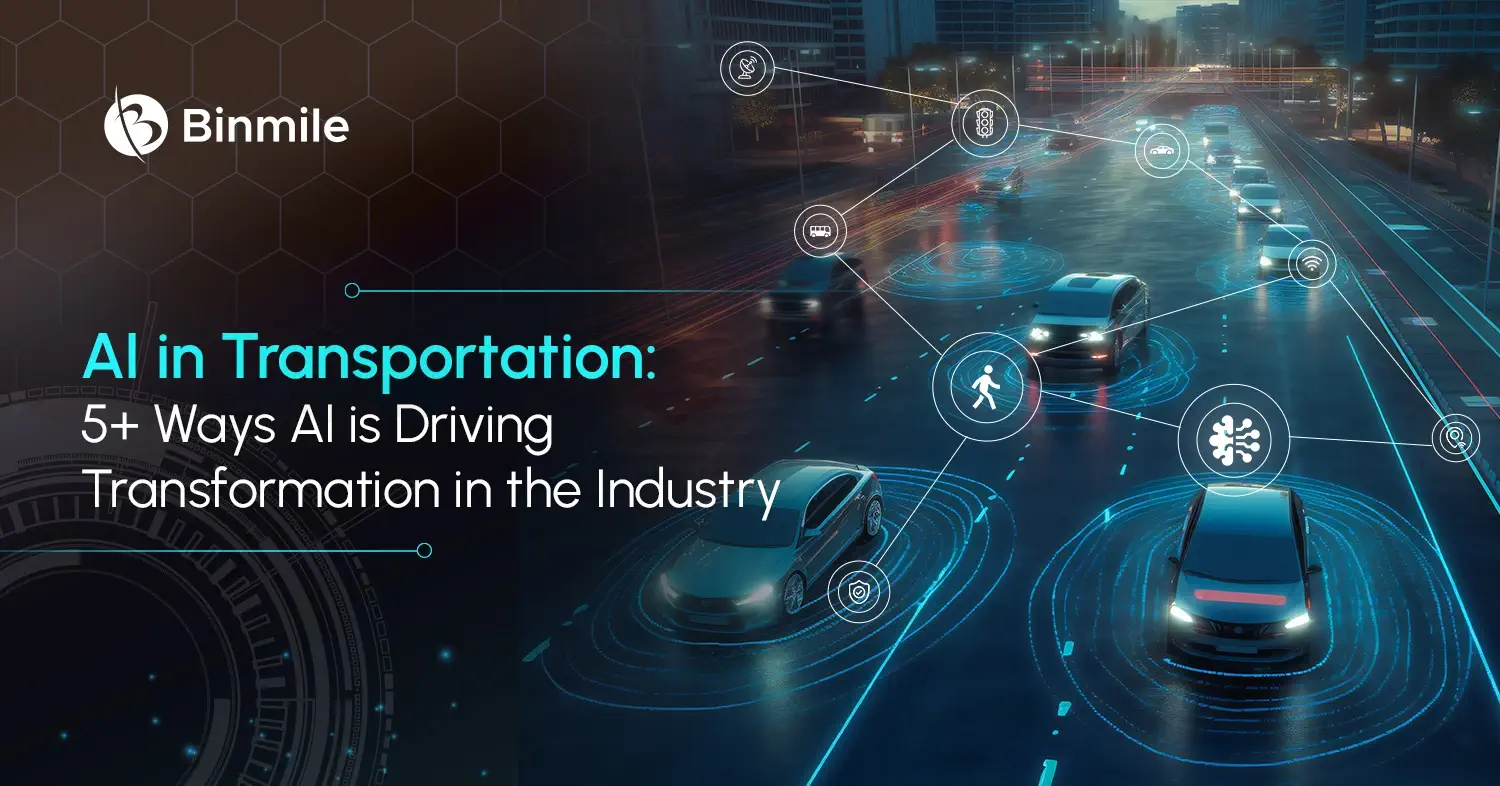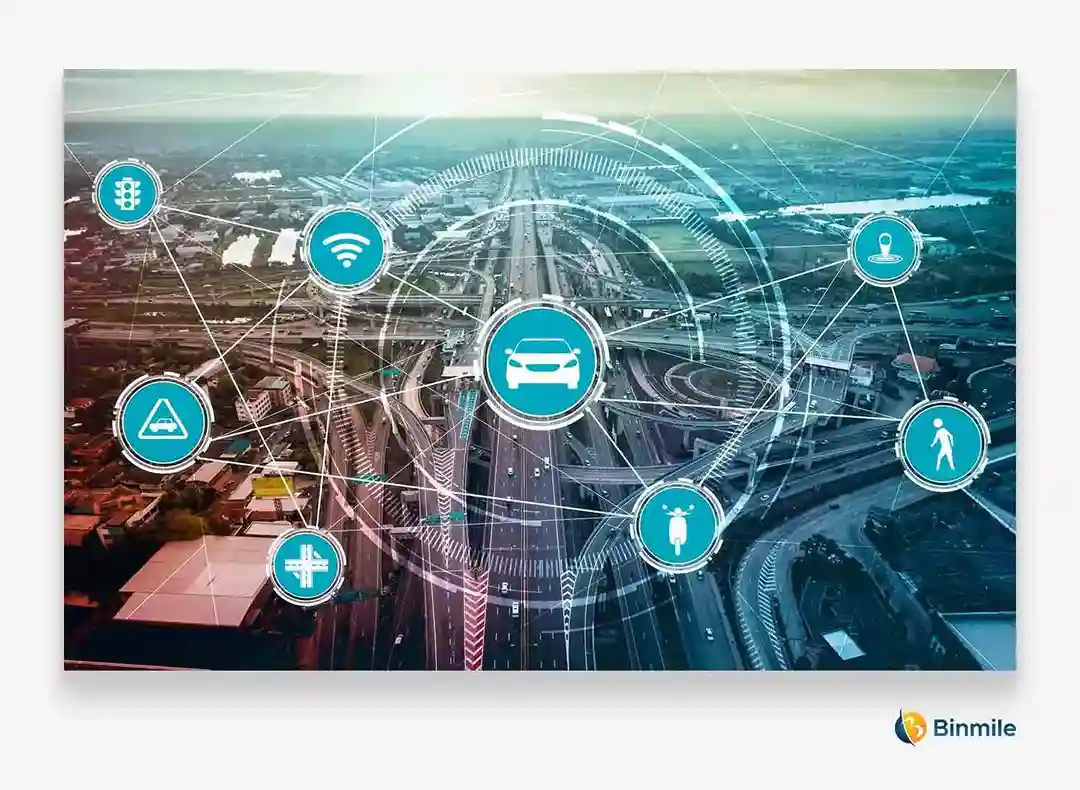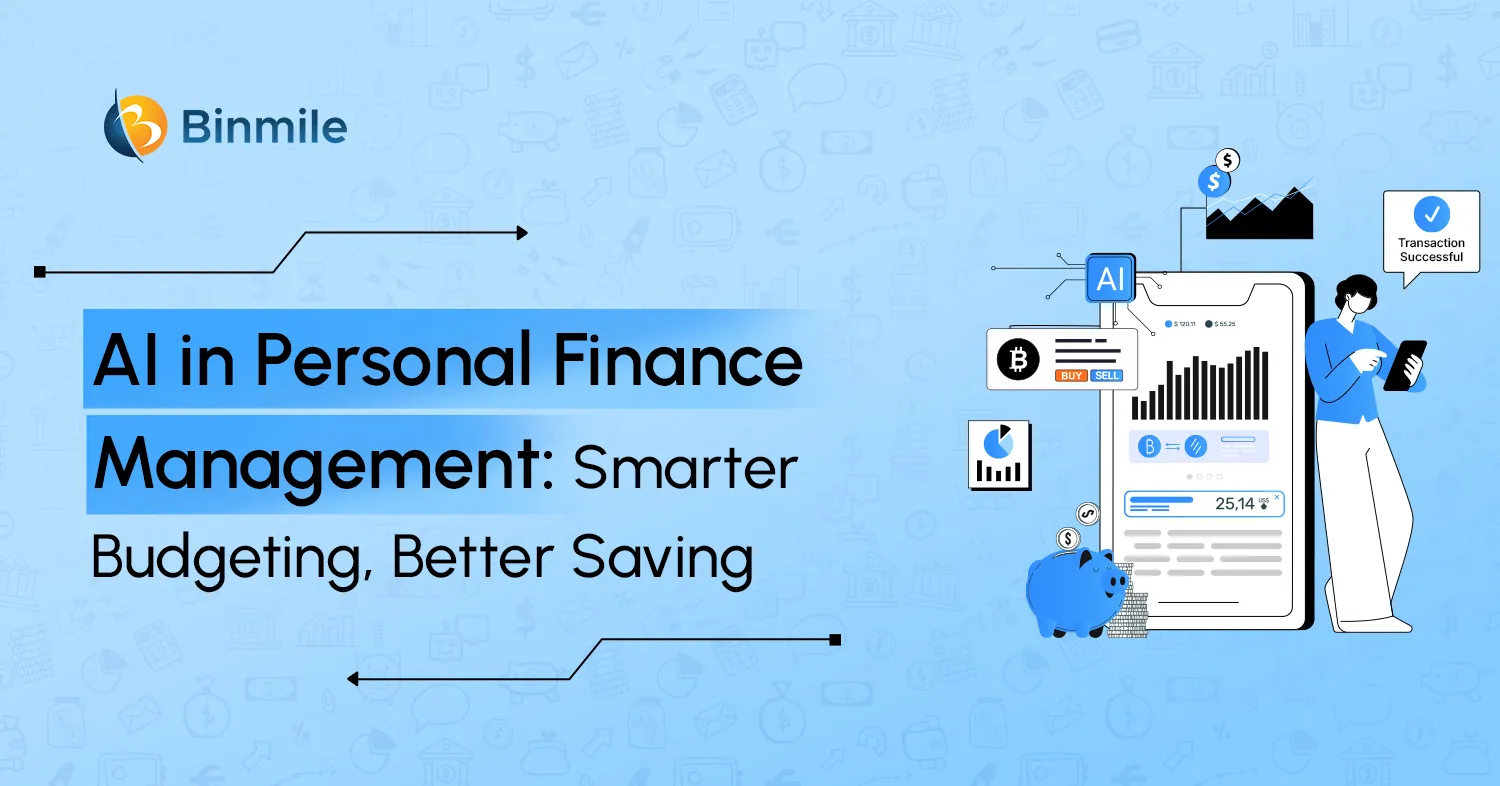Technological advancements such as IoT, self-driving cars, and AI in transportation have achieved major success in resolving challenges like road safety, traffic congestion, and infrastructure optimization. AI’s ability to analyze vast amounts of data is revolutionizing the transportation sector, leading to significant improvements. No wonder, it’s reported that 86% of public transportation providers are striving to develop and adopt AI technology projects.
How does it do it? What can it do? Imagine a world where roads are safer, commutes are stress-free, and transportation systems operate seamlessly in safety, efficiency, and overall user experience. This future isn’t just a dream – it’s closer than you think. Advancements in drone taxis and AI-powered transportation management software promise to radically transform how we move and how businesses operate logistics.
Let’s understand the way AI in transport is bringing a positive impact on the sector and logistics, as well as its practical use in the industries.
Growing Importance of AI in Transportation
- Market Growth: The global AI in transportation market is projected to reach $15.24 billion by 2030, growing at a CAGR of 12.4%.
- Traffic Congestion Reduction: Tucson, Arizona, implemented an AI-powered traffic management system that reduced road delays by up to 46% during peak hours. Boston collaborated with Google’s Project Green Light, achieving a 50% reduction in stop-and-go traffic at busy intersections.
- Safety Enhancements: AI-driven traffic signal systems in cities like Los Angeles and Pittsburgh have reduced travel times by 25% to 40%, contributing to improved road safety.
- Autonomous Vehicle Adoption: China has opened 32,000 kilometers of roads to driverless vehicles, accelerating the adoption of autonomous driving technology.
- Emergency Response Optimization: The Fremont Fire Department in California reduced cross-city travel times from 46 minutes to 14 minutes using AI-based traffic signal communication.
5 Ways AI in Transportation is Enhancing Roadway Safety & Operations
Artificial intelligence (AI) is rapidly transforming the transportation landscape, making our roads safer and more efficient. Here’s a closer look at 5 key ways AI is having a positive impact:

1: Proactive Traffic Management
Utilizing AI in transport, transport, and logistics providers can form a network of intelligent traffic cameras and sensors that constantly feed data into an AI system. This system can analyze traffic patterns in real time, predicting congestion before it occurs. For instance, traffic lights can then be dynamically adjusted to optimize flow, preventing bottlenecks and reducing the risk of accidents caused by impatient or frustrated drivers. Additionally, AI can reroute buses or emergency vehicles around congested areas, ensuring a faster response to critical situations.
2: Enhanced Roadway Safety
AI-powered cameras can monitor traffic for dangerous situations. For example, the system can detect instances of reckless driving, distracted drivers, or pedestrians entering roadways unexpectedly. In these cases, alerts can be sent to law enforcement, or warnings can be displayed on digital signs to encourage safer behavior. Furthermore, AI can analyze accident data to identify high-risk areas and recommend improvements to road infrastructure or signage.
3: Continuous Predictive Maintenance
Constant use and exposure to the natural elements, like sun or rain, can cause roads to deteriorate. AI systems can be deployed to monitor road conditions through a network of sensors embedded in the pavement. These sensors can detect subtle changes in the road surface, such as developing cracks or potholes. By analyzing this data, AI can predict when maintenance is needed, allowing for repairs to be scheduled before they become major problems and contribute to accidents.
4: Improved Incident Response
Accidents and unexpected events can significantly disrupt traffic flow. AI-based monitoring systems can detect these incidents in real time using cameras and sensors. The system can then automatically alert emergency services and initiate traffic diversion protocols, minimizing delays and ensuring a faster response to the situation. This not only reduces the risk of secondary accidents but also allows for quicker medical attention to those involved.
5: Personalized Driver Guidance
AI-powered navigation systems can learn about individual driver behavior and preferences. By taking into account factors like real-time traffic conditions, preferred routes, and historical data, these systems can provide personalized guidance to drivers. This can include suggesting alternative routes to avoid congestion, advising on optimal speeds to maintain smooth traffic flow, and even recommending rest stops when signs of driver fatigue are detected.
*Bonus Points
6: Autonomous Vehicles Induction
Through machine learning and advanced sensors, AI enables vehicles to perceive and respond to their environment, making autonomous driving a reality. It simulates human perceptual and decision-making processes using deep learning and controls actions in the driver control systems, such as brakes and steering. It can also significantly reduce accidents caused by human error, such as drunk driving, fatigue, and distracted driving. However, for safety reasons, the driver sits in the vehicle to control the car during an emergency, but with the advent of more advanced technologies, you might witness fully autonomous vehicles soon!
7: Efficient Traffic Management
To optimize traffic management flow, AI algorithms analyze real-time data from various sources, such as sensors, traffic cameras, and GPS devices. These smart traffic management systems can dynamically adjust signal timings and reroute vehicles, reducing congestion and improving efficiency. Then the passengers are updated with essential information like feasible accident instances, and road blockages, and are notified about the shortest route, helping them reach their destination without getting trapped in any traffic hassles.
Upgrade your logistics strategy with advanced AI-driven tools. Minimize risks, improve safety, and enhance operational flow.
The Rise of AI in Transportation: Look Into Efficiency, Safety & the Future
The automotive industry has already begun to integrate artificial intelligence in critical tasks like traffic management, self-driving cars, and so on, where reliability and safety will be essential in using new technology. While the most common denominators have been self-driving vehicles or smart highways, more use cases are equally useful, even though less fancy than the former. For example, intersections and pedestrian/cyclist paths are visually monitored by AI systems to detect traffic accidents and increase safety. There are other transformative benefits of implementing AI in transport management, so let’s discuss them in detail:
- AI in the automotive industry can personalize in-vehicle infotainment systems based on user preferences.
- Smarter traffic management with AI in transport can reduce traffic congestion and make journeys more enjoyable for both drivers and passengers.
- Artificial intelligence in transportation can improve interconnectivity between vehicles and surrounding systems, making the riding experience more efficient
- It can also help reduce the risk of road accidents and enhance safety by informing drivers with real-time updates about traffic conditions and potential hazards.
- Smart driving can reduce vehicle emissions while boosting fuel efficiency, thus helping improve air quality and combat climate change.
Interested in understanding how AI in transportation is enabling the connected and smart mobility network of the future, get in touch with our experts, today!
Wrapping It Up
Without a doubt, the future of AI in transportation holds revolutionary changes in the way of people’s and goods’ mobility. However, artificial technology is not just about introducing new technologies; it’s also about reinforcing and modernizing existing functions, making them more accurate, faster, and affordable. However, this future comes with the condition of the necessity to update legacy systems. This step will be crucial for businesses to remain competitive and drive next-generation transportation and logistics development solutions. Thus, as AI technology continues to develop and become more accurate, we can expect even more transformative applications.
As a business, if you’re also looking forward to fully optimizing the potential of AI, we recommend you consult a leading AI development company. Their supply chain and logistics experts can turn your data into actionable insights, driving operational efficiency, improving sustainability, and making roads, highways, and intersections safer for all.
Frequently Asked Questions
AI plays a critical role in revolutionizing transportation by enhancing safety, efficiency, and overall user experience. It enables real-time traffic management, predictive maintenance, and autonomous driving capabilities. With its ability to analyze large datasets, AI reduces congestion, minimizes accidents, and streamlines logistics operations. Additionally:
- AI reroutes vehicles to avoid congested areas.
- It ensures faster responses to emergencies by clearing paths for emergency vehicles.
Predictive maintenance leverages AI to monitor road and infrastructure conditions using embedded sensors. It identifies potential issues like cracks or potholes early and ensures timely repairs, leading to:
- Enhanced road safety and efficiency.
- Reduced maintenance costs by addressing issues proactively.
Autonomous vehicles use AI to process real-time data, enabling accurate decision-making. They:
- Reduce accidents caused by human errors like distraction or fatigue.
- Optimize routes to save time and fuel.
AI systems detect unsafe behaviors such as reckless driving and alert authorities. Benefits include:
- Identifying high-risk zones for infrastructure upgrades.
- Reducing accidents through better monitoring and insights.
AI optimizes logistics by predicting demand, analyzing data, and:
- Streamlining routes to cut delivery times.
- Enhancing vehicle interconnectivity for improved efficiency.










